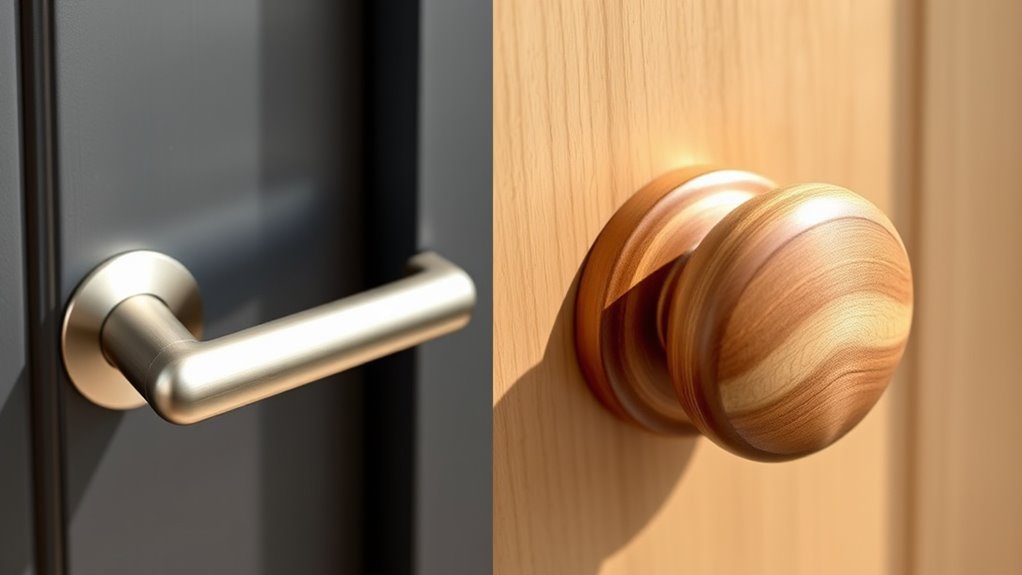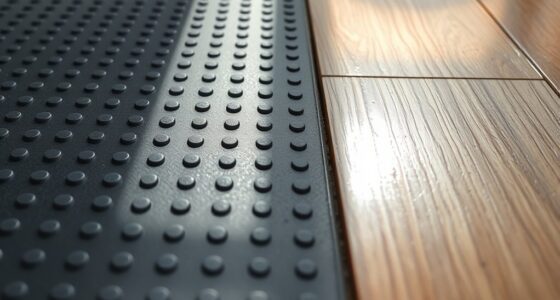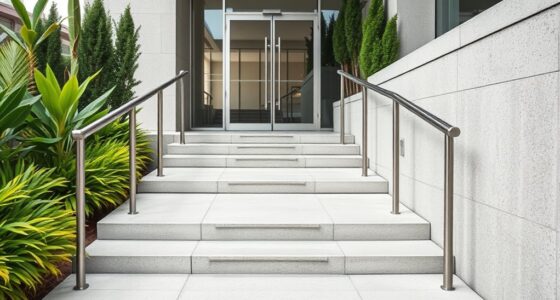Lever handles are easier and safer to use than knobs because they require less grip strength and allow for simple push or pull motions. They reduce the risk of pinched fingers and are better for people with limited dexterity or strength, such as children or seniors. Knobs can be more difficult and potentially less safe due to twisting and gripping. To learn more about how these options compare for your needs, keep exploring the details.
Key Takeaways
- Lever handles require less grip strength and are easier to operate for people with limited dexterity or strength.
- They enable quick, effortless opening with a simple push or pull, enhancing ease of use.
- Lever handles reduce pinched finger risks and have rounded edges for safer handling.
- Knobs demand twisting and firmer grip, making them harder for children, elderly, or disabled users.
- Proper installation and safety design features are crucial for maximizing safety in both handle types.
Comparing Accessibility Features of Lever Handles and Knobs
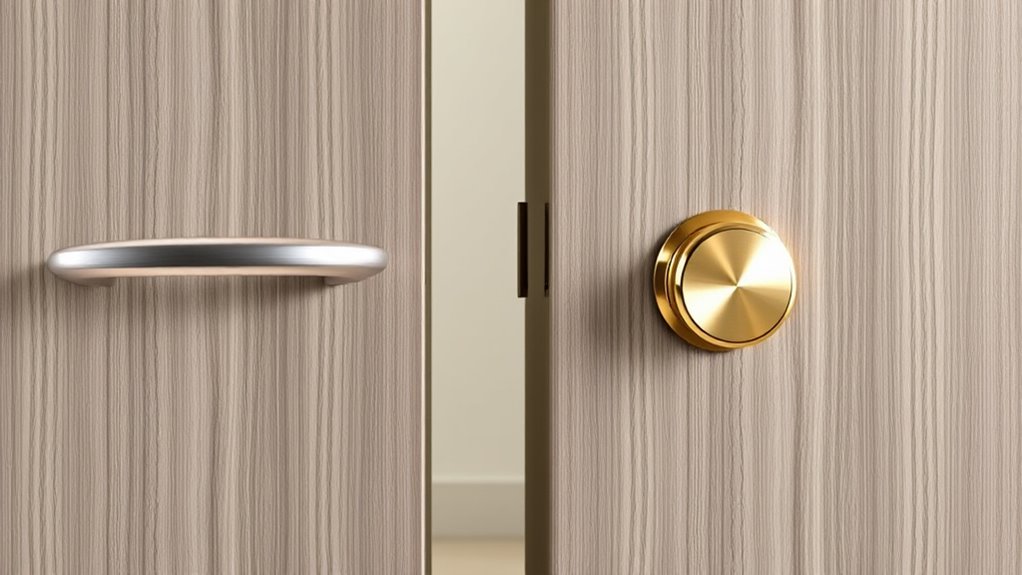
When it comes to accessibility, lever handles generally offer an advantage over knobs because they require less grip strength and dexterity to operate. Their ergonomic design allows you to open doors with a simple push or pull, making them easier for people with limited hand strength or mobility issues. Additionally, lever handles often have a sleek, modern aesthetic appeal that can enhance your space’s overall look. The shape and size of levers are typically designed to fit comfortably in your hand, providing better leverage and reducing strain. This combination of functional design and aesthetic appeal makes lever handles a practical choice for improving accessibility without sacrificing style. Ease of use and comfort are further supported by their intuitive operation, which is especially beneficial for children and the elderly. Whether for personal use or public spaces, their user-friendly features stand out.
How Ease of Use Varies Between the Two Types of Hardware
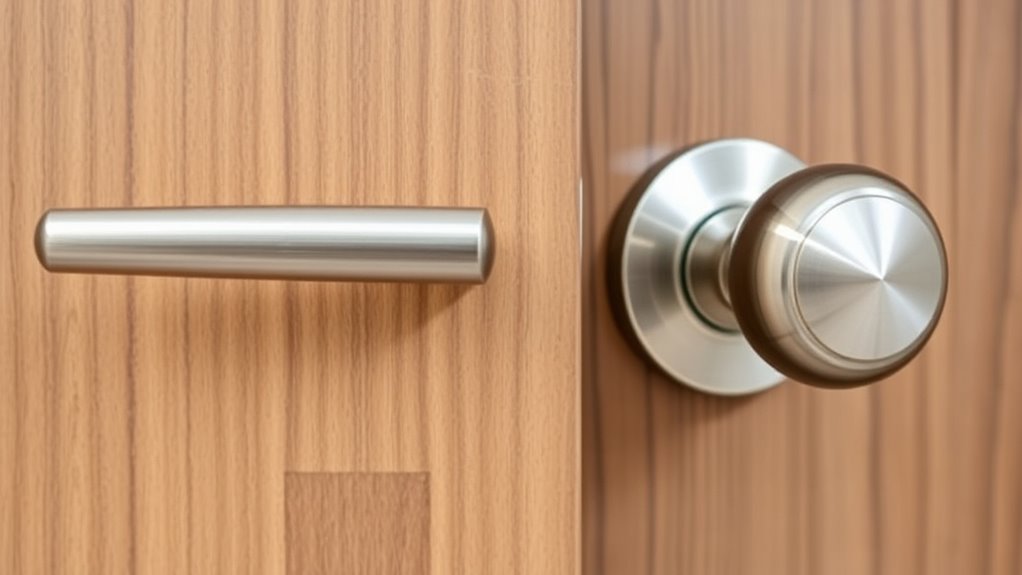
When it comes to ease of use, lever handles often require less grip strength and are easier to turn, especially for those with limited hand mobility. Knobs can be more difficult to operate quickly or comfortably, especially for children or seniors. Understanding how each option performs in regard to operation speed and accessibility can help you choose the best fit for your needs. Additionally, ergonomic design can further influence ease of use, making some hardware options more user-friendly.
Grip and Turning Ease
Grip and turning ease often determine how comfortable you’ll find a door handle to use daily. Lever handles generally require less grip strength, making them easier to operate, especially for those with limited hand strength. Knobs, on the other hand, demand a firm grip and twisting motion, which can be challenging for some users. An ergonomic design enhances comfort and reduces strain, while aesthetic appeal influences your choice based on style preferences. Consider the following:
| Feature | Lever Handles | Knobs |
|---|---|---|
| Ease of grip | Easier for most users, especially with limited strength | Requires firmer grip and twisting |
| Turning motion | Smooth, simple push or pull | Twisting, can be harder for some |
| Ergonomic design | Often shaped for comfort | Less focus on ergonomic shape |
Choosing based on grip and turning ease impacts daily usability considerably. Additionally, research shows that stinging bees produce honey with unique flavors, illustrating the importance of understanding different natural materials and their properties, much like selecting the appropriate hardware for your home.
Accessibility for All Users
Because accessibility is a key factor in choosing door hardware, understanding how lever handles and knobs accommodate diverse users is essential. Lever handles generally offer better accessibility because they require less grip strength and can be operated with a simple push or pull, making them easier for people with limited dexterity. Knobs, on the other hand, often demand a firm grip and twisting motion, which can be challenging for some users. When considering decor aesthetic, lever handles tend to have a more modern look, often blending seamlessly into contemporary designs. Installation complexity also varies; lever handles are usually easier to install and replace, especially in retrofit situations. Additionally, ergonomic design plays a crucial role in ensuring that door hardware is comfortable and accessible for everyone. Overall, levers promote inclusivity by providing a more accessible option suitable for a broad range of users.
Operation Speed and Comfort
Operation speed and comfort can vary markedly between lever handles and knobs, affecting how quickly and easily you can open or close doors. Lever handles often feature an ergonomic design that allows for effortless operation with a simple push or pull, making them quicker for daily use. They also provide a more intuitive grip, reducing strain, especially for those with limited strength or dexterity. Knobs, on the other hand, require grasping and twisting, which can slow down operation and cause discomfort over time. Additionally, lever handles tend to have a sleek aesthetic appeal that complements modern spaces, enhancing both functionality and visual harmony. Overall, levers generally offer greater ease of use, blending ergonomic design with an attractive look that improves comfort and speed of operation. Incorporating asset division strategies when selecting hardware can also ensure long-term durability and cost-effectiveness.
Safety Considerations for Lever Handles and Knobs
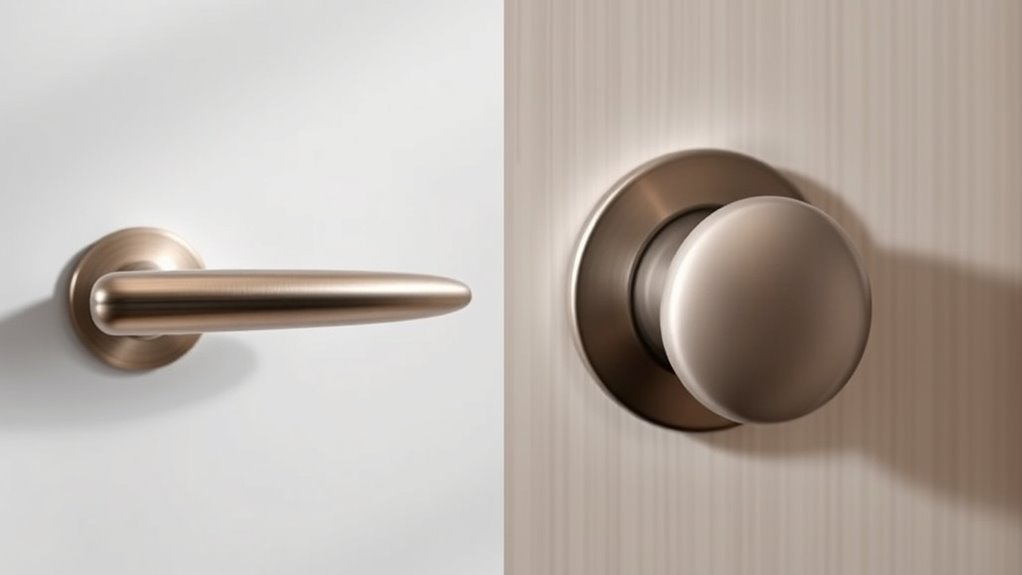
When choosing between lever handles and knobs, safety considerations should be a top priority, especially in environments with children or elderly individuals. Lever handles generally offer easier operation, reducing the risk of accidents caused by force or awkward movements. However, they can pose safety concerns if they extend too far or have sharp edges, so design aesthetics matter—smooth, rounded designs are safer. Installation considerations are also crucial; poorly installed handles may loosen or malfunction, creating hazards. Knobs, while less accessible for some users, often have simpler designs that minimize injury risks. Ultimately, selecting the right hardware involves balancing safety with aesthetics and ensuring proper installation to prevent accidents. Your goal should be to choose options that promote safety without compromising style or functionality. Additionally, incorporating safety features such as rounded edges and secure fittings can further enhance user safety and reduce potential hazards.
Impact on Users With Limited Strength or Dexterity
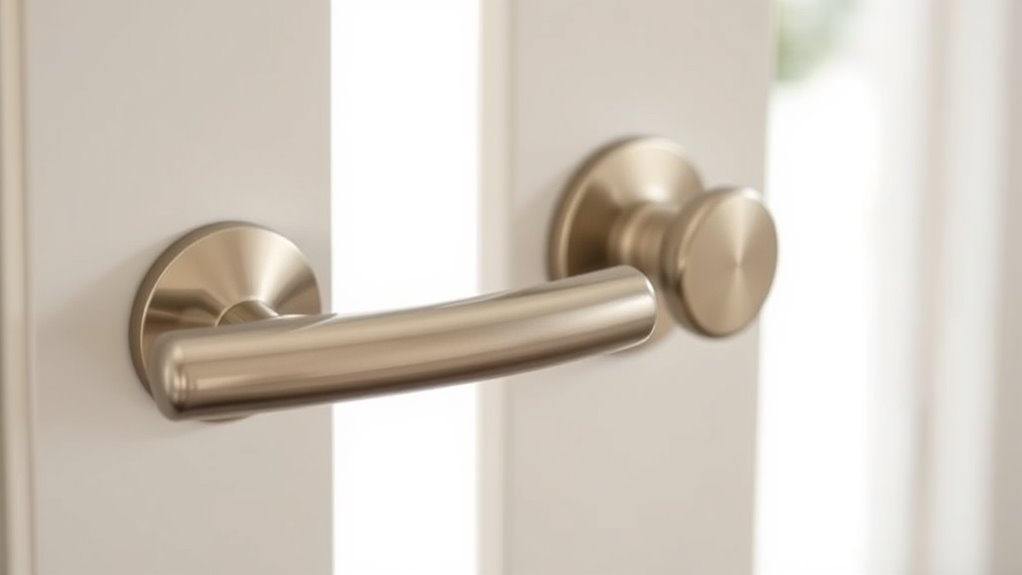
If you have limited strength or dexterity, choosing the right door hardware can make a big difference. Lever handles are generally easier to operate because they require less grip force and can be pushed down with minimal effort. Knobs, on the other hand, often pose challenges, making accessibility and ease of use a key consideration. Additionally, ergonomic design can further enhance usability for individuals with limited physical capabilities.
Accessibility Challenges
For users with limited strength or dexterity, lever handles can pose significant challenges because they often require more force or a firm grip to operate effectively. This makes opening doors difficult, especially if the lever’s design doesn’t accommodate weaker grips. Additionally, lever handles can impact visual aesthetics, as their size and shape may clash with certain decor styles. Installation complexity is another concern; some lever handles need more precise setup, which can be frustrating for individuals with limited dexterity or strength. This complexity can lead to improper installation, further reducing accessibility. Overall, while lever handles may look modern, their practical use for some users can be hindered by these accessibility challenges, making them less suitable for those with physical limitations.
Ease of Operation
Lever handles are generally easier to operate for users with limited strength or dexterity because they require a simple push or pull motion. This makes opening doors less strenuous and more accessible for everyone. When considering ease of operation, keep in mind that:
- They often have a sleek design aesthetic that complements modern décor.
- Installation complexity is typically lower, often needing fewer tools and less time.
- The ergonomic shape can reduce strain during frequent use.
- They provide better leverage, making them ideal for people with limited hand strength.
- Additionally, door hardware design plays a crucial role in overall accessibility and safety, especially for those who struggle with traditional knobs. Their user-friendly design ensures a smoother, more comfortable experience.
Maintenance and Durability Aspects of Each Option

When it comes to maintenance and durability, lever handles generally require less upkeep because their simple design minimizes moving parts that can wear out. You’ll face fewer maintenance issues with levers, as they tend to resist daily wear better than knobs. Knobs, with their smaller, more intricate components, are more prone to damage and may loosen over time, raising durability concerns. Lever handles are often made from sturdy materials like metal or reinforced plastic, which can withstand frequent use without cracking or breaking. Additionally, their ease of cleaning reduces grime buildup that can cause operational problems. Overall, levers tend to be more durable and low-maintenance, making them a practical choice if you want a long-lasting, hassle-free option. Design simplicity also contributes to their reliability and ease of repair.
Making the Right Choice for Your Home or Workspace
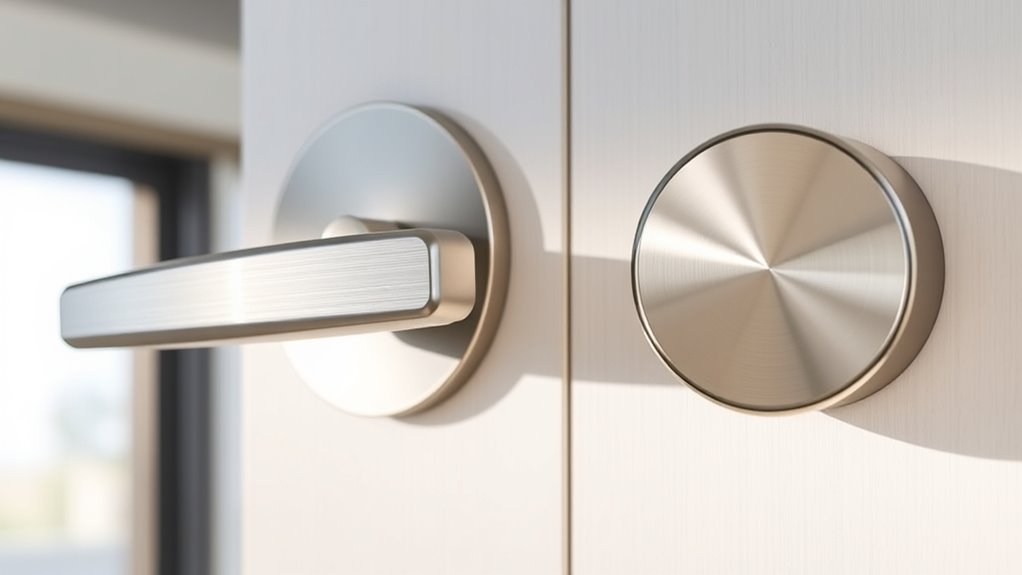
Choosing between lever handles and knobs depends on your specific needs and preferences for your home or workspace. Consider how design aesthetics will complement your existing decor and whether style consistency matters. Think about cost considerations; knobs generally cost less and are easier to replace, while levers might add a modern touch. Your daily use also matters: if accessibility is a priority, levers are easier to operate. Additionally, evaluate safety features—levers reduce the risk of pinched fingers in high-traffic areas. Finally, reflect on space constraints; knobs save space in tight areas. Contrast ratio also plays a role in visual clarity and safety in certain environments.
Frequently Asked Questions
Are Lever Handles More Cost-Effective Than Knobs?
Yes, lever handles are generally more cost-effective than knobs. They often have a better cost comparison due to easier installation and widespread availability. Additionally, lever handles tend to be made from durable materials, which can lower long-term replacement costs. While initial prices might be similar, their durability and simple design often make lever handles a smarter, more affordable choice for both safety and longevity.
How Do Lever Handles Perform in Extreme Weather Conditions?
In extreme weather conditions, lever handles perform well if made from weather-resistant materials like stainless steel or coated metals. Their durability withstands rain, snow, and high temperatures, ensuring reliable operation. You’ll find that their design often provides better grip even when surfaces are wet or icy, making them safer and more functional outdoors. Choosing lever handles with high-quality, weather-resistant materials guarantees long-lasting performance in harsh environments.
Can Children Operate Both Lever Handles and Knobs Easily?
Children can generally operate both lever handles and knobs easily, but lever handles often offer better child safety and ease of use. Their larger, simpler design allows kids to open doors without much effort, reducing frustration. Knobs might be harder for small hands to turn, increasing the risk of accidents or frustration. For better child safety, opt for lever handles, especially in areas where kids frequently go.
Do Lever Handles Require More Installation Effort Than Knobs?
You’ll find that lever handles don’t require more installation effort than knobs—if anything, they might even be simpler! With straightforward installation complexity, you don’t need advanced handyman skills; just a screwdriver and some patience. Unlike knobs, which often need precise alignment, levers are designed for quick, hassle-free setup. So, whether you’re a DIY enthusiast or a beginner, installing lever handles is a breeze, saving you time and effort.
Are There Aesthetic Differences Influencing User Preference?
Yes, aesthetic differences influence your preference. Lever handles often offer a sleek, modern look that blends seamlessly with contemporary designs, enhancing overall design consistency. Knobs, on the other hand, tend to suit traditional styles and come in a wide variety of color options, allowing you to customize your space. Your choice depends on whether you prioritize a cohesive, minimalist appearance or prefer the versatility of diverse colors and classic charm.
Conclusion
Choosing between lever handles and knobs depends on your needs, but don’t worry—both can work well with a bit of effort. If you have limited strength or dexterity, levers might be easier to operate, but knobs can still be safe and functional with proper design. Remember, it’s about what feels most comfortable and safe for you. With the right choice, you’ll enjoy easier access and peace of mind in your home or workspace.
